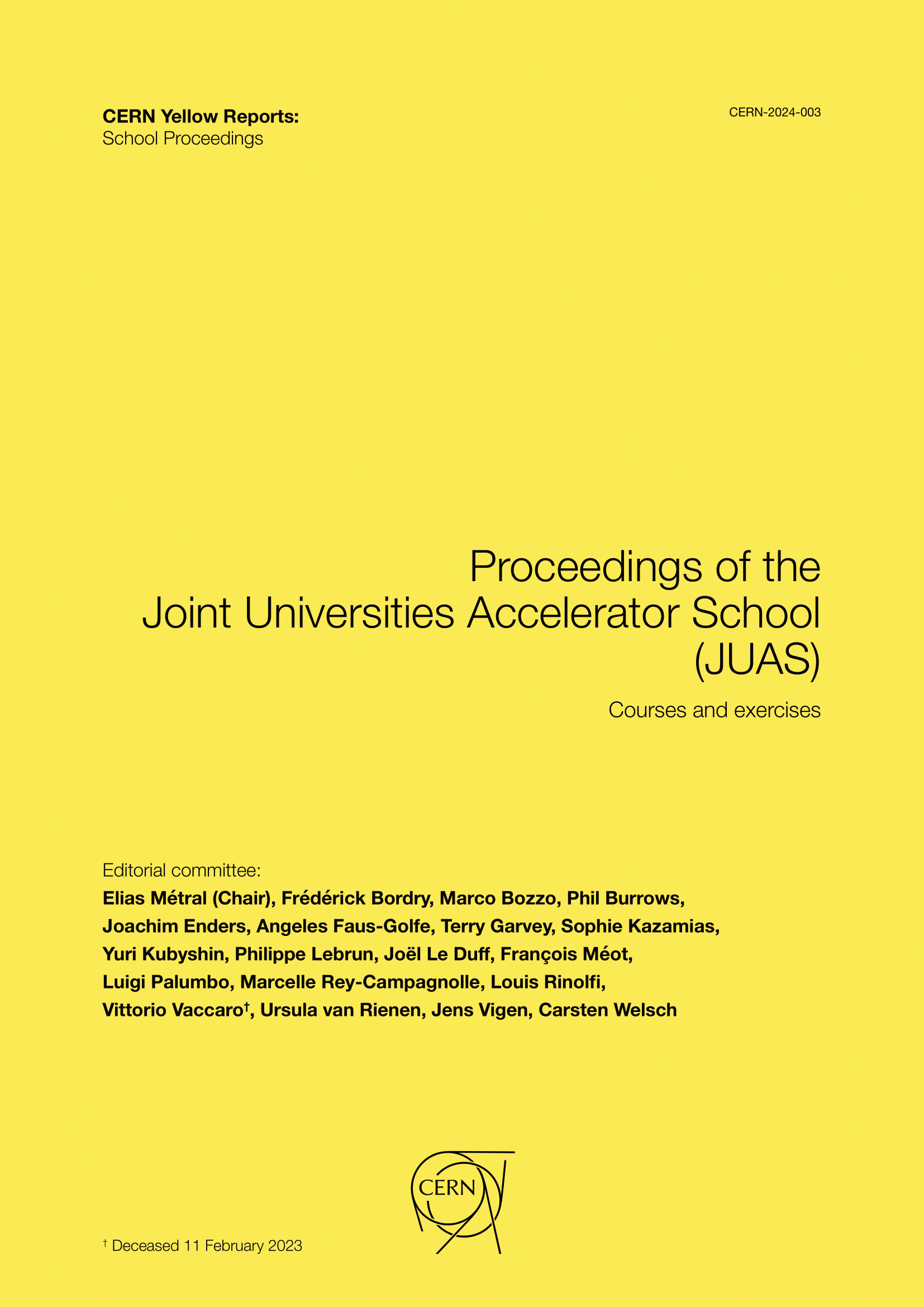Part II — The technology and applications of particle accelerators— JUAS Course 2
DOI:
https://doi.org/10.23730/CYRSP-2024-003.731Abstract
Part II, covering JUAS Course 2, is the "heaviest" part: the technology and applications of particle accelerators. The first chapters deal with the core of the machines, the equipment that accelerates particle beams (RF systems) and those that bend or steer them (magnets). After reviewing the electromagnetism theory underlying the RF engineering of accelerators and the key aspects of this technology (cavities, power sources, etc.), a long chapter introduces basic RF concepts and principles relevant to the design of accelerator RF systems. The limitations of using copper technology to increase the particle energy led to the development of superconducting RF cavities. An overview of the state of the art of superconducting RF technology is given, and this underlines the importance of surface preparation and of diagnostics of RF superconductors. A similar approach applies to magnets: the foundational principles and tools required for the analytical design of a simple accelerator magnet are followed by those relevant to superconducting magnets. Here, superconductivity allows enormous savings in weight, volume, and energy consumption. Another chapter explores the advantages of using superconductors in accelerators, the conditions under which superconducting magnets and superconducting RF cavities are used, and the optimisations required for these materials. This is followed by a brief overview of cryogenics—applicable to the cooling of these superconducting devices—that "presents the basic processes, gives the correct orders of magnitude, and alerts the system designer to possible pitfalls". Another essential component of an accelerator is its vacuum system, as the circulating beam must avoid collisions with any molecules along its path to maintain its quality. Vacuum science and technology have been established and refined over a long period; however, since the advent of cryogenics in accelerators, vacuum conditions at cryogenic temperatures have been further studied, leading to the development of new technologies to achieve ultra-high vacuum levels. Beam instrumentation covers a "large and complex field". Knowing the beam parameters (beam current, profile, position, etc.) is essential for the operation and development of any accelerator. Particle sources are the equipment specifically designed to generate the particle beams; a chapter focuses on several types of sources according to the type of particles (electrons, positrons, or ions) and on the extraction of the beam from these sources. A chapter on survey and alignment explains how the components of an accelerator are positioned as close as possible to their theoretical position using geodetic metrology. Then comes a chapter on accelerator controls: "the control system is a central part of all accelerators. Its main task is to integrate the autonomous controllers distributed throughout the facility into a coherent infrastructure". A consideration of radiation safety provides insights into the importance of managing ionising radiation hazards, which are inevitable when working with accelerators. A detailed development of this topic addresses radiation shielding, safety systems, and monitors. Towards the end of this part of the volume, several specific accelerators are presented from an application standpoint: low-energy accelerators (the most numerous), with energies of less than 50 MeV, have now achieved compact, reliable, and efficient designs and are widely used in medicine and industry; high-power proton linacs are considered as drivers for energy saving, material science, etc.; manufactured cyclotrons that can produce protons/ions of a few hundred MeV for medical treatments; and a particular compact recirculating electron accelerator for industrial applications. The chapter on the physics of particle therapy explains the choice of proton/ion beams to treat cancer and the role of the gantry in transporting and positioning the beam for the patient. This part concludes with a chapter on the life-cycle and operation of particle accelerators.
Published
Issue
Section
License

This work is licensed under a Creative Commons Attribution 4.0 International License.
Authors who publish with this publication agree to the following terms:
- CERN retains copyright and publishes the work licensed under the Creative Commons Attribution License 4.0 that allows others to share the work with an acknowledgement of the work's authorship and initial publication in this series.
- Authors are able to enter into separate, additional contractual arrangements for distribution of the published version of the work (e.g., post it to an institutional repository or publish it in a book), with an acknowledgement of its initial publication in this series.
- Authors are permitted and encouraged to post their work online (e.g., in institutional repositories or on their website) prior to and during the submission process, as it can lead to productive exchanges, as well as earlier and greater citation of published work (See The Effect of Open Access).

